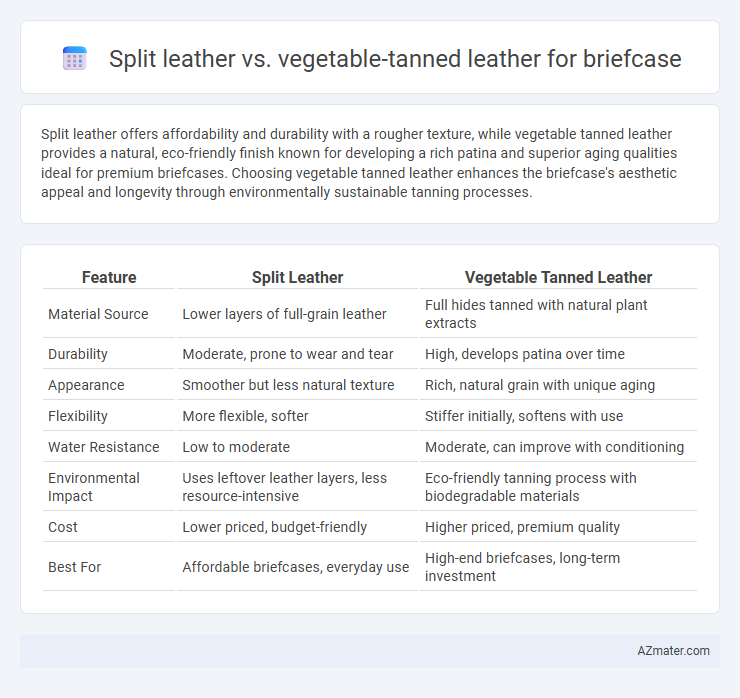Split leather offers affordability and durability with a rougher texture, while vegetable tanned leather provides a natural, eco-friendly finish known for developing a rich patina and superior aging qualities ideal for premium briefcases. Choosing vegetable tanned leather enhances the briefcase's aesthetic appeal and longevity through environmentally sustainable tanning processes.
Table of Comparison
| Feature | Split Leather | Vegetable Tanned Leather |
|---|---|---|
| Material Source | Lower layers of full-grain leather | Full hides tanned with natural plant extracts |
| Durability | Moderate, prone to wear and tear | High, develops patina over time |
| Appearance | Smoother but less natural texture | Rich, natural grain with unique aging |
| Flexibility | More flexible, softer | Stiffer initially, softens with use |
| Water Resistance | Low to moderate | Moderate, can improve with conditioning |
| Environmental Impact | Uses leftover leather layers, less resource-intensive | Eco-friendly tanning process with biodegradable materials |
| Cost | Lower priced, budget-friendly | Higher priced, premium quality |
| Best For | Affordable briefcases, everyday use | High-end briefcases, long-term investment |
Introduction to Leather Types for Briefcases
Split leather, derived from the lower layers of a hide, is commonly used in affordable briefcases due to its durability and cost-effectiveness, though it lacks the natural grain and aging characteristics of higher-quality leather. Vegetable tanned leather, crafted using natural tannins from plant sources, offers superior strength, enhanced patina development, and increased rigidity, making it a premium choice for briefcases that require longevity and a classic aesthetic. Understanding these leather types helps consumers select briefcases that balance budget constraints with desired durability and appearance.
What is Split Leather?
Split leather is created by dividing a hide into layers, separating the inner fibrous part from the top grain, resulting in a less durable and more porous material often used for budget briefcases. Vegetable tanned leather, by contrast, undergoes a natural tanning process using plant extracts, offering superior durability, a rich patina, and enhanced water resistance ideal for high-quality briefcases. Choosing vegetable tanned leather over split leather ensures a briefcase with better structural integrity and long-term aesthetic appeal.
What is Vegetable Tanned Leather?
Vegetable tanned leather is a natural leather tanning process using tannins and other ingredients found in plant matter, fruits, and barks, resulting in a durable and eco-friendly material. Unlike split leather, which is made from the fibrous part of the hide after splitting, vegetable tanned leather retains the full grain surface, providing better strength, patina development, and aging characteristics. This makes vegetable tanned leather ideal for briefcases due to its rigidity, longevity, and aesthetically pleasing finish.
Appearance and Texture Differences
Split leather features a rougher, more fibrous texture with a matte finish, making it less smooth and polished compared to vegetable tanned leather. Vegetable tanned leather offers a rich, natural patina that deepens with age, showcasing a smooth, firm surface that enhances the briefcase's aesthetic appeal. The distinct grain and firmness of vegetable tanned leather contribute to a premium, classic look, whereas split leather appears more rugged and utilitarian.
Durability: Split vs Vegetable Tanned Leather
Vegetable tanned leather offers superior durability compared to split leather, as it is crafted from the full grain layer, retaining natural toughness and resistance to wear. Split leather, derived from the lower layers of the hide, tends to be less durable and more prone to stretching or tearing under heavy use. For briefcases requiring long-lasting strength and a premium finish, vegetable tanned leather is the optimal choice.
Aging and Patina Development
Split leather tends to develop a less desirable aging process with limited patina due to its lower fiber quality and surface coating that inhibits natural wear. Vegetable tanned leather, prized for briefcases, exhibits rich patina development, deepening in color and texture over time through exposure to light and handling. The natural oils and tannins in vegetable tanned leather enhance durability and aesthetic appeal, resulting in a unique, character-rich finish that improves with age.
Water and Stain Resistance Comparison
Split leather exhibits lower water and stain resistance compared to vegetable tanned leather due to its open fiber structure and thinner top grain. Vegetable tanned leather undergoes a natural tanning process using plant extracts, enhancing its durability and ability to repel moisture and stains effectively. For briefcases exposed to frequent handling and environmental stress, vegetable tanned leather offers superior protection against water damage and staining over split leather.
Environmental Impact and Sustainability
Split leather, derived from the fibrous part of the hide left after the top-grain is separated, generally undergoes more intensive chemical processing, increasing its environmental footprint compared to vegetable tanned leather. Vegetable tanned leather, treated with natural tannins from tree bark and plants, is biodegradable and often produced with less harmful chemicals, aligning better with sustainable practices. Choosing vegetable tanned leather for briefcases supports eco-friendly manufacturing and reduces landfill waste due to its compostable nature and lower pollution in processing.
Price and Value for Briefcases
Split leather briefcases are generally more affordable due to the use of lower-quality leather layers, offering decent durability but less prestige. Vegetable tanned leather, often priced higher, provides superior aging, strength, and a unique patina that enhances the briefcase's value over time. Investing in vegetable tanned leather briefcases ensures better long-term value despite the initial cost difference.
Which Leather is Better for Your Briefcase?
Vegetable tanned leather offers superior durability and develops a rich patina over time, making it an excellent choice for high-quality briefcases that age gracefully. Split leather, derived from the lower layers of the hide, is generally less durable and more prone to wear and tear, though it can be more affordable. For a briefcase that combines longevity, aesthetic appeal, and strength, vegetable tanned leather is typically the better investment.

Infographic: Split leather vs Vegetable tanned leather for Briefcase
 azmater.com
azmater.com